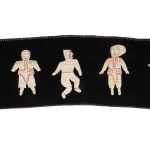-
Artworks
UNIDENTIFIED ARTIST, ARVIAT (ESKIMO POINT)
Untitled Work on Cloth, mid 1970sstroud, caribou skin, embroidery floss, and cotton thread, 16.25 x 58.5 in (41.3 x 148.6 cm)
unsigned.20$ 750.00This joyful work on cloth was acquired in situ by a schoolteacher working in Arviat in the mid 1970s. The scraped caribou skin appliqué figures that seem to dance across...This joyful work on cloth was acquired in situ by a schoolteacher working in Arviat in the mid 1970s. The scraped caribou skin appliqué figures that seem to dance across the cloth background illustrate the clothing traditions of the Kivalliq region. They showcase garments central to traditional Inuit life: women’s amautiit and men’s attigi parkas, tailored outerwear designed for survival in Arctic climates. The clothes are adorned with recognizable details: distinct stitching patterns, hood shapes, and decorative elements. These embellishments not only highlight the artistry of garment-making but also demonstrate how these skills transitioned naturally into the creation of textile art.
The connection between making clothing and works on cloth is foundational to Arviat’s art movement, as it is in the art of Qamani'tuaq. Inuit women were adept at sewing garments with precision and creativity, embedding functional items with aesthetic care. This tradition evolved seamlessly into the creation of skin appliqué “wall hangings” as artists began to reinterpret their practical sewing skills for decorative and expressive purposes. By using the same materials and techniques—stitching, layering, and working with skins—they transformed a utilitarian craft into a new medium for storytelling.
We wish we knew who created this absolutely charming work. It reminds us of the impressive works on cloth by Mina Seel (Hilu) Arnalukjuak (1927-d); however, her figures were rather more “realistically” rendered and were usually featured alongside animals in more narrative compositions. This work has a marvelously naïve quality but also a delicacy that we find incredibly appealing. It’s possible that it’s an early work by Joy Kiluvigyuak Hallauk (1940-2000), made before she began adorning her works with the beadwork for which she is justly famous—but that is just a guess; there were no doubt many Arviat women who tried their hand at making works on cloth in the late 1960s and 1970s. It’s the dance-like stances of the figures that bring her to mind for us.
Provenance
Galerie Elca London, Knowlton, QC.
Join our mailing list
* denotes required fields
We will process the personal data you have supplied in accordance with our privacy policy (available on request). You can unsubscribe or change your preferences at any time by clicking the link in our emails.




